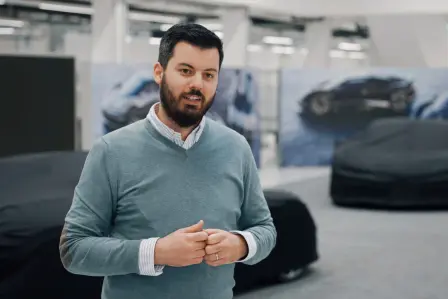
Defining the visual identity for a new Bugatti era
Molsheim
The latest episode of the Bugatti ‘A New Era’ docuseries debuts on YouTube today, lifting the lid on the pivotal moment in February 2022 when the Bugatti design team presented their proposals for the design of the Tourbillon¹. The challenge was unlike any before, designed with the foresight of generations into the future to create a car that will not only inspire the brand’s next century but remain relevant Pour l’éternité.






From sketches to virtual reality CAD models, the design team – overseen at this time by former Bugatti Design Director Achim Anscheidt and his successor, Frank Heyl – had whittled down their many designs into these final proposals. For many months, they had been developing ideas that drew upon more than a century of Bugatti history, reimagined legendary design cues from the marque’s most iconic models and sought to maintain a clear Bugatti identity, as it enters an all-new era. Finally, meticulously crafted into full-size painted models, February 2022 was the time when these ideas would be presented to the board and the final design chosen for feasibility studies over the next months.
“At Bugatti, the opportunity to begin a new era of design is extremely rare. Since the Veyron – almost 20 years ago – Bugatti cars have been designed around our legendary W16 powertrain but now comes the chance for us to completely transform the identity around an all-new hybridized V16 engine. It’s my job to recommend a design to our board and shareholders for this new era and one that distils the essence of modern-day Bugatti DNA into a single design – a car that, from any distance, unmistakably represents the brand’s unparalleled legacy."
Achim Anscheidt
Former Bugatti Design DirectorThis moment was an important point in time not just in the development of the Tourbillon but also for how the imminent and long-term future of the Bugatti brand would evolve. The design of this car will influence each new Bugatti of this era, as well as act as a source of design inspiration for generations of Bugatti designers still to come.
The process of narrowing down the design studies was not merely a matter of aesthetics. It was a comprehensive evaluation of how each design would fare on its journey to a full production car, including its technical feasibility, its ability to meet homologation requirements, and the need to preserve the iconic design elements that make a Bugatti instantly recognizable. For a car capable of travelling more than 400km/h, it’s also extremely important that aerodynamics and thermodynamics are perfectly balanced.
“Once we make the decision, the engineers’ job begins, to make sure that somehow, they get it to work as close as possible to what the designers want to have. And then there starts this very close collaboration between the designers and engineers.”
Mate Rimac
CEO of Bugatti RimacFollowing the presentation of the models, the solution became clear. The board and the design teams agreed that the most authentic and timeless exterior design for this new era of Bugatti was an amalgamation of design elements from the presented models.
"Today, we are laying the foundations for the next 100 years of Bugatti," said Mate Rimac. "This is not just about creating another hyper sports car; it’s about defining what Bugatti will represent for generations to come, so we have to get it right. The decisions we make now will determine the brand’s future, just like the Chiron became the blueprint for a number of derivatives and special editions since its introduction in 2016.”
The finalization of the Tourbillon’s design was a significant milestone, but it is just the beginning of the journey to the first deliveries in 2026. Already, with two-and-a-half years passed since this pivotal moment, the design has been refined into its final production form and presented to the world. Following its world premiere at the home of Bugatti in June the reaction has been so positive that all 250 production slots were allocated shortly after it was revealed.
Watch the full episode ‘A New Era: Determining the Future’ on the official Bugatti YouTube channel.
